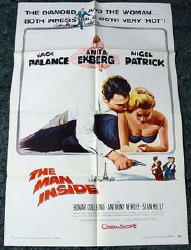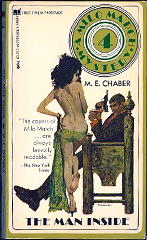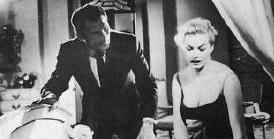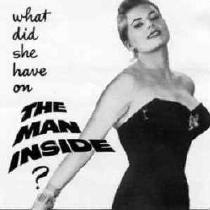Sun 13 Jul 2008
THE MAN INSIDE. Warwick Films/Columbia, 1958. Jack Palance, Anita Ekberg, Nigel Patrick, Anthony Newley, Bonar Colleano, Sid James, Donald Pleasence. Based on the novel by M. E. Chaber. Director & co-screenwriter: John Gilling.

Jack Palance plays Chaber’s well-traveled insurance investigator Milo March in this black-and-white Cinescope feature from the late 1950s. Considering all of the capital cities in Europe that the film takes place in, not to mention the opening scenes in New York City, I think the film ought to have been in color.
Especially considering who his co-star was, and I don’t mean Nigel Patrick. The look that Palance gives Anita Ekberg from the bottom of a rooming-house set of stairs, with her at the top looking down, in the tightest-fitting dress you can imagine — well, maybe you can imagine, and no, while black-and-white may cut it in some movies, it does not in this one.

Reviews for this movie online are few and far between, but they range from “tawdry” to “classic British noir,” and of course the truth (or rather, my opinion) is somewhere around halfway between. (Although it is a crime film, sure enough, it doesn’t really qualify as noir, and if it had been filmed in color, as suggested above, it wouldn’t occur to anyone to call it noir.)
Story line: A mousy accountant named Sam Carter (played by Nigel Patrick, last seen here in The League of Gentlemen) waits 15 years before finally stealing a near priceless diamond from a Manhattan jewelry dealer, and Milo is the guy the insurance company sets on his trail.
Complicating matters is that Milo is not the only one after the diamond, and Trudie Hall is one of them, although (according to her) she has a legitimate claim on it. Villainous Martin Lomer (Bonar Colleano) does not, and ever their tracks shall cross.

From Lisbon, to Madrid (where March picks up an eager-to-please taxidriver assistant, amusingly played by Anthony Newley), to Paris, to London by train — I love movies that take place on trains, and this one’s no exception.
There is, in fact, to pick up on a word I just used in the last paragraph, as much light humor in this mystery as there is violence, and I enjoyed that as well — the humor, I mean.
The title of the movie (and of course prior to that, the book) comes from the fact that everyone has two sides to them: the outward one that everyone sees, and the man inside, who finds he cannot resist temptation and if and when given the opportunity, will take immediate action and advantage of it.
As a small side note, one that I meant to mention above, Nigel Patrick was so well-disguised as the accountant-turned-thief (and then killer), I did not recognize him. With glasses and a mustache, he was that accountant, played to perfection with a capital P.

Jack Palance’s youthful skull-faced features take some getting used to, as does his Texas accent, but his brash way of approaching matters soon make the unusual casting decision long-forgotten.
As for Miss Ekberg, in 1958 she was very nearly the Eighth Wonder of the World. No acting ability would have been required, but the modicum she possessed at the time this movie was made was surely enough.
Of movies recently reviewed here on the blog, director John Gillings’s previous one was The Pirates of Blood River (1962). The Man Inside apparently came before the bulk of the ones he did for Hammer.
October 13th, 2013 at 1:57 pm
I first viewed Anita Ekberg when the film the Mongols was shown on channel 9 in NY,NY. It was my pleasure then & still today. In the film THE MAN INSIDE, she is breathtaking. I have never seen any woman on this planet as beautiful as Anita Ekberg. She defines the ultimate in beauty. Coupled with all of her, it is impossible to take one’s eyes off of her. With the many movies she has made, I can honestly say I may know all of her lines in each movie. It was always my wish to spend time with her either on or off the screen. In this movie, she comments to Jack Palance:”Perhaps because I have concealed weapons.” An understatement to say the least. She also propositions the very lucky Jack Palance in the police station that:”Maybe my proposition interested you too much.” And that “he was afraid of himself.” After Anita was beaten up in this movie, Jack Palance echoes the sentiment “scout’s honor” to console her in the bed where she felt ashamed of herself asking Mr.Palance for a cigarette. No one could be as lucky as Mr.Palance when the beautiful Anita propositioned him in Donald Pleasance’s hotel room. I’ve seen this movie over 100 times and I will always continue to do so along with her numerous films.
October 13th, 2013 at 6:52 pm
John
It’s nice to have someone finally comment on this review, some five years later. Thanks! Nor can I disagree with you about Anita Ekberg, not at all.
— Steve